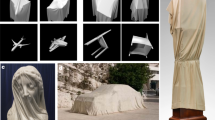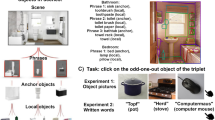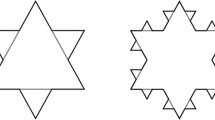The mysterious appeal of a simple and ancient composition of rocks is unveiled.
Abstract
The dry landscape garden at Ryoanji Temple in Kyoto, Japan, a UNESCO world heritage site, intrigues hundreds of thousands of visitors every year with its abstract, sparse and seemingly random composition of rocks and moss on an otherwise empty rectangle of raked gravel1. Here we apply a model of shape analysis in early visual processing2,3 to show that the 'empty' space of the garden is implicitly structured and critically aligned with the temple's architecture. We propose that this invisible design creates the visual appeal of the garden and was probably intended as an inherent feature of the composition.
This is a preview of subscription content, access via your institution
Access options
Subscribe to this journal
Receive 51 print issues and online access
$199.00 per year
only $3.90 per issue
Buy this article
- Purchase on Springer Link
- Instant access to full article PDF
Prices may be subject to local taxes which are calculated during checkout


Similar content being viewed by others
References
Nitschke, G. Japanese Gardens (Taschen, Cologne, 1993).
Blum, H. J. Theor. Biol. 38, 205–287 (1973).
Van Tonder, G. J. & Ejima, Y. IEEE Trans. Syst. Man. Cybernet. B (in the press).
Oyama, H. Ryoanji Sekitei: Nanatsu no Nazo wo toku (Ryoanji Rock Garden: Resolving Seven Mysteries) (Kodansha, Tokyo, 1995).
Kovacs, I. & Julesz, B. Nature 370, 644–646 (1994).
Leyton, M. Comp. Vis. Graph. Image Proc. 38, 327–341 (1987).
Taylor, R. P. Nature 415, 961 (2002).
Taylor, R. P., Micolich, A. P. & Jonas, D. Nature 399, 422 (1999).
Author information
Authors and Affiliations
Corresponding author
Ethics declarations
Competing interests
The authors declare no competing financial interests.
Rights and permissions
About this article
Cite this article
Van Tonder, G., Lyons, M. & Ejima, Y. Visual structure of a Japanese Zen garden. Nature 419, 359–360 (2002). https://doi.org/10.1038/419359a
Issue Date:
DOI: https://doi.org/10.1038/419359a
This article is cited by
-
A virtual reality home-based training for the management of stress and anxiety among healthcare workers during the COVID-19 pandemic: study protocol for a randomized controlled trial
Trials (2022)
-
Visual Geometry of Classical Japanese Gardens
Axiomathes (2022)
-
A Zen Master, a Zen Monk, a Zen Mathematician
Nexus Network Journal (2018)
-
The Epistemological Status of Vision and its Implications for Design
Axiomathes (2005)
-
Visual Perception in Japanese Rock Garden Design
Axiomathes (2005)
Comments
By submitting a comment you agree to abide by our Terms and Community Guidelines. If you find something abusive or that does not comply with our terms or guidelines please flag it as inappropriate.



